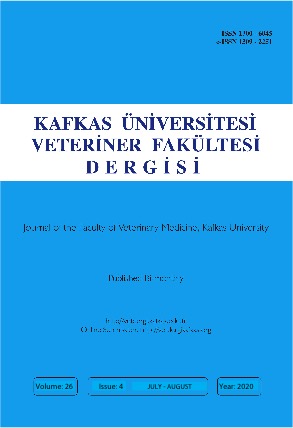
This journal is licensed under a Creative Commons Attribution-NonCommercial 4.0 International License
Kafkas Üniversitesi Veteriner Fakültesi Dergisi
2020 , Vol 26 , Issue 4
Coherence of Clinical Symptoms at Antemortem Inspection and Pathological Lesions at Postmortem Inspection in Slaughter Pigs
1University of Belgrade, Faculty of Veterinary Medicine, Department of Food Hygiene and Technology, Bulevar Oslobodjenja 18, 11000 Belgrade, SERBIA2University of Ljubljana, Veterinary Faculty, Institute of Food safety, Feed and Environment, Gerbičeva 60, 1000 Ljubljana, SLOVENIA
3University of Ljubljana, Veterinary Faculty, Clinic for Ruminants and Pigs, Clinic for Reproduction and Farm Animals, Cesta v Mestni log 47, 1000 Ljubljana, SLOVENIA DOI : 10.9775/kvfd.2020.23884 The aim of this study was to examine the relationship between clinical symptoms recorded during the antemortem inspection in the lairage and pathological lesions at postmortem inspection of slaughter pigs. If clinical symptoms were an accurate indicator of pathological lesions at postmortem inspection it could be possible to incorporate only those parameters in the health and welfare monitoring system. The study was conducted on 1033 pigs originated from 39 small-scale farms. During the antemortem inspection, pigs were clinically inspected for the presence of coughing, sneezing and laboured breathing. The plucks of slaughtered pigs from each farm were examined for pneumonia, pleurisy and liver milk spots. No relationship was found between clinical symptoms and pathological lesions using Spearman correlation analysis. According to receiver operating characteristic curves and the area under the curves, "positive farms" for pathological lesions at the postmortem inspection could not be accurately detected by the clinical symptoms recorded during antemortem inspection. These results suggest that the recording of pathological lesions at postmortem inspection is more reliable and feasible method for pig health and welfare monitoring than the recording of clinical symptoms during the antemortem inspection. Therefore, incorporating of pathological lesions scoring as part of the routine postmortem veterinary inspection process could function as iceberg indicators of underlying problems affecting pig health and welfare at farm level. Keywords : Coughing, Liver milk spots, Lung lesions, Receiver operating characteristic analysis, Sneezing










